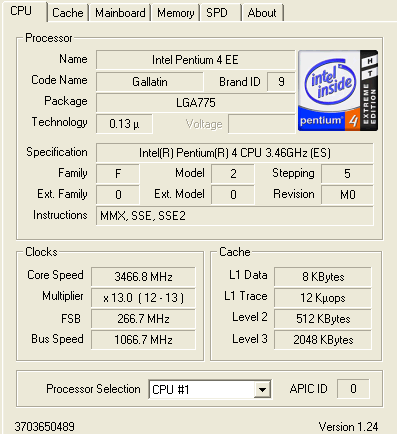3.46GHz Extreme Edition
The launch of a chipset supporting hither-to unseen system speeds needs a new range of CPUs, right?. CPU multipliers need to be reduced to accommodate the faster system speed, so older 200MHz CPUs, assuming they're factory-locked, will only be able to run at 925XE's base frequency of 266MHz with a sharp jump in CPU speed.The first 925XE-ratified CPU is none other than an Extreme Edition model. Motherboards based on the 925XE chipset will be feature-rich, performance-orientated and will appeal to enthusiasts, so having an Extreme Edition as the first CPU makes a reasonable amount of implicit sense.

It looks just like any other LGA775 processor when viewed from the top. The performance enhancement lies underneath the heatspreader.

LGA775 processors have contact pads on the CPU and the usual pins located directly on the motherboard. Some reckoned that having contact pins on the motherboard was a bad idea. Fragility and ease of breakage were touted as reasons why. I found it just as easy to install and remove this LGA775 CPU as any S478 processor.

A few things to note here. All Extreme Edition CPUs improve performance over regular models by adding a whopping 2MB of on-chip 8-way associative L3 cache. Simplifying the working process hugely, having a stack of extra memory, comparatively-speaking, housed right on the CPU and running at full core speed improves performance by reducing the number of times that system RAM, running hugely slower, has to be accessed for data. Extra on-chip cache is especially important in applications that require large chunks of data at one time. A classic example is gaming, and Intel has always pushed its Extreme Edition line as a gamers' favourite. Adding 2MB of L3 cache does improve performance via a brute force approach but also has the nasty side-effect of raising transistor count to around 180m and die size to around 237mm². That makes for a range of CPUs which have often been labelled Expensive Edition. We're looking at £700 or so for this model alone.
CPU-Z identifies it as a Gallatin-based processor, that is, derived from server Xeon CPUs. Also, although it is presented in an LGA775 form factor, this CPU is based on Northwood and not Prescott core architecture. That infers a 0.13-micron manufacturing process, 1.5v operating voltage, a shorter integer pipeline, no SSE3 support, and 'only' 512kb L2 cache. Performance differences between Pentium 4 architectures have been documented in greater detail before.
I'm a touch deflated that Intel has only felt confident enough to release a 1066MHz FSB Extreme Edition at 3.46Hz clock speed. We first saw a 3.4GHz Northwood CPU back in February 1st this year. The current Intel Pentium 4 560 LGA775 Prescott-based processor already runs at 3.6GHz and a 3.8GHz model will be available imminently. One problem in raising system bus speed is the MHz jumps between integer multipliers. A 3.72GHz clock speed is required for a multiplier of 14 which, I reckon, would cut the number of validated E.E down significantly.
| Name | Pentium 4 3.46GHz Extreme Ed. | Pentium 4 3.4GHz Northwood | Pentium 4 560 | AMD FX-55 | AMD Athlon 64 4000+ |
| Clock speed | 3466MHz | 3400MHz | 3600MHz | 2600MHz | 2400MHz |
| L1 cache | 20kb | 20kb | 20kb | 128kb | 128kb |
| L2 cache | 512kb | 512kb | 1024kb | 1024kb | 1024kb |
| L3 cache | 2048kb | - | - | - | - |
| FSB | 266MHz quad pumped | 200MHz quad pumped | 200MHz quad pumped | 2600MHz (core speed) | 2400MHz (core speed) |
| Pipeline length | 20 stages | 20 stages | 31 stages | 12 stages | 12 stages |
| Socket | LGA775 | S478 | LGA 775 | S939 | S939 |
| Manufacturing process | 0.13-micron | 0.13-micron | 0.09-micron | 0.13-micron | 0.13-micron |
| Transistor count | ~180 million | 55 million | 125 million | 106 million | 106 million |
| CPU die size | 237mm² | 127mm² | 112mm² | 193mm² | 193mm² |
| Voltage | ~ 1.525v | ~1.525v | 1.25 - 1.4v | 1.5v | 1.5v |
| Memory support (preferred) | DDR2-533 DC | DDR400 DC | DDR2-533 DC | DDR400 DC | DDR400 SC |
| Other | 2MB L3 cache | Last NW | Prescott core | 32/64-bit | On-die controller |
2MB of L3 cache and a faster system bus speed is what marks the 3.46GHz Extreme Edition out. Let's now see how it performs.









